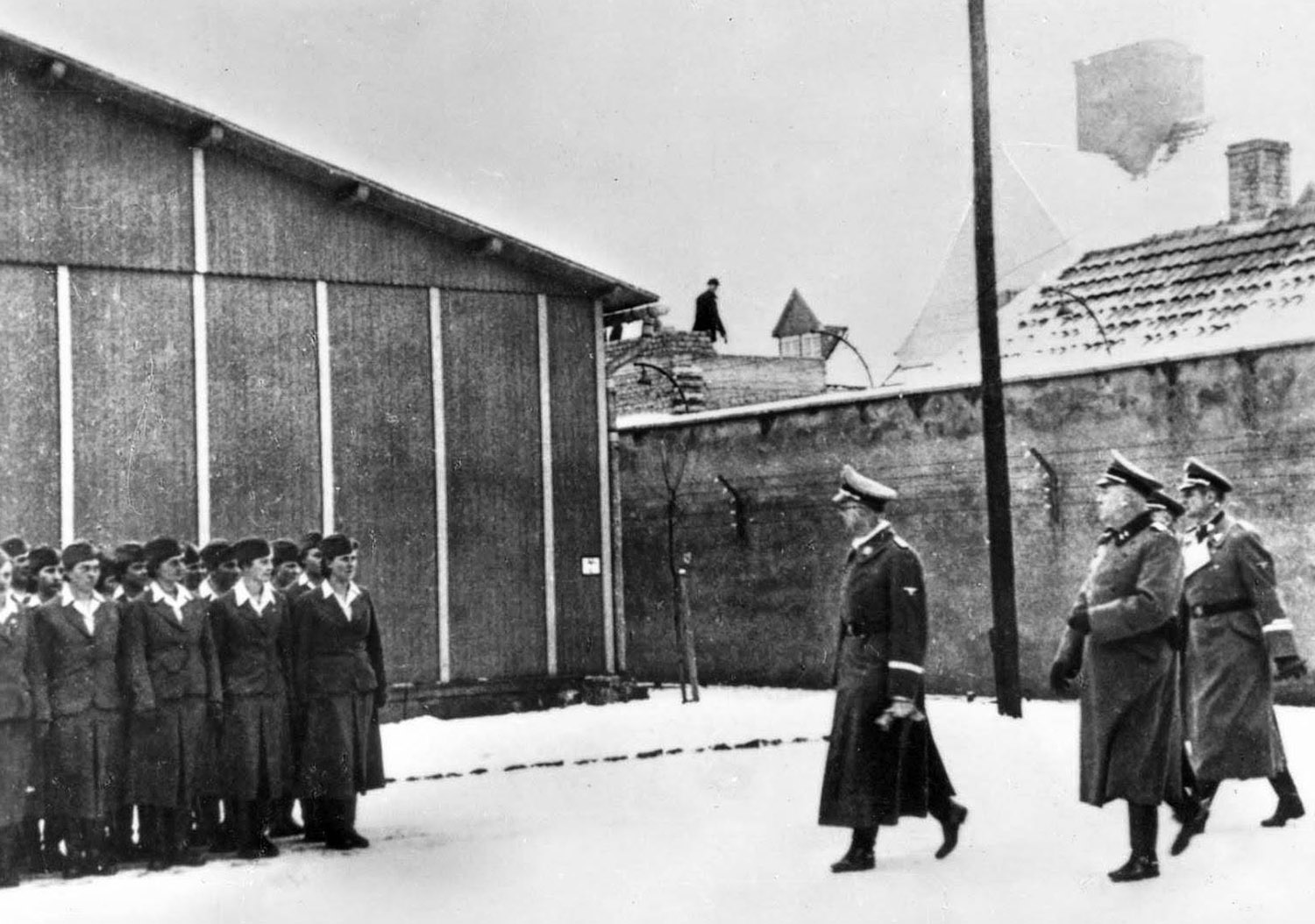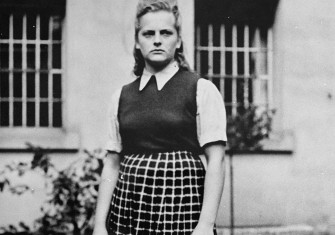Who Worked at Ravensbrück?
In Nazi Germany, a number of female doctors and nurses worked at Ravensbrück concentration camp, where medical treatment was replaced by negligence, experimentation and violence. What led these women to take jobs there?

Heinrich Himmler inspects Ravensbrück concentration camp, c.1940.
In 1944, Gerda Schröder, a community nurse from the spa town of Bad Oeynhausen in northern Germany, decided that she wanted to further her career. Having worked as a nurse in various towns, Shröder wanted to train as an OP-Schwester (an operating theatre nurse). Seeking training in a hospital near Berlin, she asked her supervisor for a transfer. She was not sent to the capital. Instead, authorities posted her to Ravensbrück, a concentration camp some 90 kilometres north of Berlin.
Later, as a witness at the first Ravensbrück trial, conducted by British military authorities between December 1946 and February 1947, Schröder would tell prosecutors that she protested against her posting, but was firmly told that she must work at the camp. In later testimony, the nurse stated that she had ‘never dreamed’ of this outcome. Learning of her posting she was ‘outraged’, ‘furious’ and said a job at Ravensbrück went entirely against her wishes – even if she was able to fulfil her ambition of working as an operating theatre nurse. Schröder did not detail why she refused to work at Ravensbrück, but her reluctance to go there indicates that she probably had some idea of the cruelty which took place at the camp – even if she claimed to have had ‘no idea’ of what it would be like. This suggests more widely that ‘ordinary Germans’ did at least know something about what went on in the concentration camps. After the war, Schröder was not prosecuted by the Allies for her job at Ravensbrück, presumably because numerous survivors of the camp testified that she had been helpful and kind to them.

Ravensbrück concentration camp was opened in May 1939 on the orders of Heinrich Himmler, the head of the SS. It was a camp for women. Prior to the establishment of Ravensbrück, a camp named Lichtenburg housed in a Renaissance castle near Wittenberg also incarcerated women, but was closed in 1939 because Himmler desired the construction of a larger institution to house more female prisoners. Prisoners in Ravensbrück included Jews, Roma and Sinti gypsies and ‘asocials’ – women who did not conform to the National Socialist vision of the Volksgemeinschaft (‘people’s community’). Women involved in resistance movements against the Nazi regime were also incarcerated at Ravensbrück. They were subjected to forced labour, which involved the production of armaments in order to aid the German war effort. It is estimated that about 130,000 women were imprisoned in the camp. About 50,000 died of starvation and illness, while 2,200 were murdered in the gas chambers built in 1941; the function of the camp changed in accordance with the Nazi desire to eradicate all ‘undesirables’, including Jews, the disabled, the chronically ill and other persecuted groups. Major Stewart, a prosecutor at the postwar Ravensbrück trials, remarked that the camp grew into ‘an enormous extermination machine’. When the camp was liberated by Soviet soldiers in April 1945, 15,000 people had survived.
Unsurprisingly, medical facilities at Ravensbrück were bad and grew steadily worse as Nazi policies of persecution intensified during the war and the numbers of women sent to the camp increased. Medical treatment administered by doctors in the camp hospital, known as the Revier, was extremely poor. Keith Mant, a forensic pathologist who was in charge of the Special Medical Section of the British Army’s War Crimes Group, remarked that ‘a doctor in a concentration camp is almost a contradiction in terms’ based on his observations at Ravensbrück. The nurses at the camp, all of whom were female, also demonstrated a total lack of compassion. Helena Esther Goudsmit, who was a prisoner at the camp and a witness at the fourth Ravensbrück trial, which took place from May to June 1948 and was conducted by British authorities in order to convict the medical staff of the camp, stated:
The German nurses never had any professional activity, they looked on the misery of the sick with the greatest indifference and even sarcasm and never made any effort whatsoever to help them even though it was possible for them to do so.
Doctors and nurses administered lethal injections to prisoners they deemed ‘unfit’ for work. Human experiments took place at the camp, which occurred without the informed consent of the women who were operated on. Between 1942 and 1943, Professor Karl Gebhardt and other Nazi doctors carried out experiments that entailed the creation of artificial wounds in the legs of prisoners, which were then infected with glass, sawdust and wood in order to test the effectiveness of sulfonamide drugs on healing infections. Several women died as a result. Others were shot as the perpetrators attempted to conceal the evidence. Those who survived suffered life-changing injuries. The experiments concluded that sulfonamide drugs were an inadequate method of treating wounds. This was already known to Gebhardt before the experiments took place; they had absolutely no scientific legitimacy.

The exact numbers of medical staff who worked in the hospital are difficult to accurately estimate, as the number fluctuated during the war. We know, however, that three female doctors worked at Ravensbrück: Herta Oberheuser, Erika Jantzen and Gerda Weyand. With regard to the number of nurses, Keith Mant noted that there was an Oberschwester (Head Nurse) and a ‘varying number of SS or German sisters’. At any one time, there were roughly six nurses who worked in the hospital. These nurses were usually members of the Reichsbund nationalsozialistischer Schwestern. Dr Percy Triete, who worked in the hospital at Ravensbrück and was convicted in the medical trial, noted that ‘each SS sister supervised a block and her job was mainly to organise’.
How did these female medical professionals come to work at Ravensbrück? Each journey was different. Like Schröder, Elizabeth Marschall, Oberschwester at Ravensbrück, arrived at the camp under compulsion from the authorities, working there from 1943 until the end of the war. But Marschall was sent to Ravensbrück as a punishment. She had previously worked at the Hermann Göring Werke, an industrial complex in Braunschweig, where she was also employed as an Oberschwester. As a defendant in the first Ravensbrück proceedings conducted by British military authorities, Marschall stated that the SS had accused her of giving two French prisoners food at the Hermann Göring Werke and was sent to Ravensbrück as a punishment. Marschall spoke to inmates in French, which, she stated at her postwar trial, ‘got me the disliking of the people around me’. She remained at the camp until liberation. She was accused of war crimes, including withholding medicine from prisoners and selecting people to be gassed, at the first postwar Ravensbrück trial. She was found guilty and subsequently executed.
That both Schröder and Marschall claimed to have been posted to Ravensbrück involuntarily raises a question: could they have refused their postings? There is debate among historians about whether women were compelled to work in concentration camps. Gudrun Schwarz argues that the labour-conscription process the female camp guards underwent was a common form of wartime recruitment, but was not always compulsory. However, Irmtraud Heike and Bernhard Strebel argue that female guards were compulsorily recruited to concentration camps by labour offices, especially after ‘total war’ was instigated in 1943. Requiring more labour, all women between the ages of 17 and 45 were obliged to report to their local labour office to be assigned work.
It is not clear whether nurses who were conscripted to work at Ravensbrück would have had a choice, but, given the dates that Schröder and Marschall were posted to the camp – in 1943 and 1944, as ‘total war’ was being implemented – it does seem plausible that they could not have refused their orders. However, it is likely that they only had to work at the camp for a year; Schröder noted in later testimony that she left Ravensbrück after this period of time since she had completed her year of service. It is possible that Marschall, on the other hand, chose to remain at the camp.
Erika Jantzen and Herta Oberheuser were two female doctors who worked at Ravensbrück. Jantzen’s position at Ravensbrück was a continuation of her previous job. She was a gynaecologist and stated in an affidavit produced for the Nuremberg War Crimes trials that she ‘applied to the head doctor of the SS Topenkorf units and concentration camps’ for a job at Lichtenberg concentration camp. She did not give a reason for applying. Jantzen secured a job at the camp and worked there from 1938. Lichtenberg was evacuated when Ravensbrück was built and the prisoners were moved to Ravensbrück in May 1939. Jantzen came straight from Lichtenberg to Ravensbrück and worked as a doctor there. She left camp service in 1940 when she married and had a child, conforming to the Third Reich’s ideal that German women should not work and instead devote themselves to motherhood and the family. After the war, Jantzen ran her own medical practice. It is not known why Jantzen was not subjected to the postwar trials, but it is likely that she was either hard to track down or there was not enough available evidence of her crimes for a conviction.

Herta Oberheuser went to work at Ravensbrück voluntarily. She wanted to develop her career and improve her financial situation. Oberheuser obtained her medical degree at Bonn University in 1937, specialising in dermatology. She then worked at several clinics in Düsseldorf before responding to a newspaper advertisement for a ‘women doctor at a re-education centre in Ravensbrück’ in 1940. The statement of Dr. Rosenthal – another doctor who worked at the camp – in an examination as part of the first postwar Ravensbrück trial suggests that Oberheuser was motivated by career concerns. He noted that she saw her position at the camp as her ‘life’s work’. Economic constraints caused by the war hampered Oberheuser’s career prospects; her defence at the Nuremberg Doctors’ Trial, conducted by US military authorities between December 1946 and August 1947, argued that it was ‘impossible for her to set up her own practice when the war broke out in view of the heavy expenses and general restrictions brought about by war’. Accused of war crimes, Oberheuser was sentenced to 20 years in prison, but only served five, and started practising as a doctor again in Germany before her license was formally revoked by court authorities in 1958.
Historians have been slow to acknowledge the role of female medical personnel in committing crimes during the Third Reich. Yet the paths of female medical personnel to Ravensbrück differed markedly; it is simply not enough to say that some were compelled to come to the camp while others volunteered. Gerda Schröder was instructed to work at the camp after requesting training as an operating theatre nurse. Elizabeth Marschall was sent to Ravensbrück as a form of punishment. Erika Jantzen’s path to the camp resembled a logical continuation of her career. Herta Oberheuser desired to work at Ravensbrück as she actively sought career development. Recognising the differences in individual paths to Ravensbrück reveals how people from different backgrounds became complicit in the crimes of the Third Reich and how the regime’s politics of persecution were ultimately executed on a national scale.
Kate Docking is completing a PhD at the University of Kent on the female doctors and nurses who worked at Ravensbrück concentration camp during the Third Reich.




